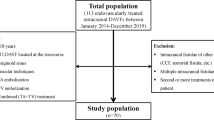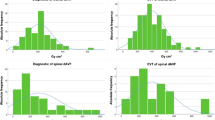Abstract
Background
Among neurointerventional procedures, the embolization of complex shunt lesions usually requires more radiation dose. We aimed to evaluate the procedural outcome and safety in using low-dose DSA protocols for intracranial dural arteriovenous fistula (AVF) embolization treatment.
Methods
Between January 2014 and July 2018, 55 patients with dural AVFs who underwent endovascular treatment were included in the study. The low-dose group (n = 27) included from January 2016 used various low-dose DSA protocols made by modifying the thickness of the copper filter or the detector entrance dose. We compared radiation dose metrics, such as air-kerma, kerma-air product (KAP), and fluoroscopy time, as well as clinical and imaging outcomes with the conventional-dose group (n = 28) included before January 2016.
Results
The total KAP was 40.1% lower in the low-dose group (87.9 vs. 146.7 Gy cm2, p = 0.002). The average number of DSA runs (25.1 vs. 25.5, p = 0.86) and fluoroscopy times (77.4 vs. 69.7 min, p = 0.48) were similar between the groups. An immediate favorable occlusion rate (total or near total occlusion) was achieved in 41 (74.5%) patients. Ten patients (18.2%) underwent additional procedures due to residual (n = 6) and/or recurrent (n = 5) lesions. At a median of 10 months follow-up, 45 patients (86.5%) had achieved favorable occlusion. Treatment outcomes showed no significant between-group differences. There was one case (1.8%) of procedure-related complications in the low-dose group. All but one patient showed favorable clinical outcomes (modified Rankin score ≤ 2).
Conclusion
The low-dose protocols were feasible by showing significant radiation dose reduction and acceptable procedural outcome.




Similar content being viewed by others
References
Alexander M, Oliff M, Olorunsola O, Brus-Ramer M, Nickoloff E, Meyers P (2010) Patient radiation exposure during diagnostic and therapeutic interventional neuroradiology procedures. J Neurointerv Surg 2:6–10. https://doi.org/10.1136/jnis.2009.000802
D’Ercole L, Thyrion FZ, Bocchiola M, Mantovani L, Klersy C (2012) Proposed local diagnostic reference levels in angiography and interventional neuroradiology and a preliminary analysis according to the complexity of the procedures. Phys Med 28:61–70. https://doi.org/10.1016/j.ejmp.2010.10.008
Ihn YK, Kim BS, Byun JS, Suh SH, Won YD, Lee DH, Kim BM, Kim YS, Jeon P, Ryu CW, Suh SI, Choi DS, Choi SS, Choi JW, Chang HW, Lee JW, Kim SH, Lee YJ, Shin SH, Lim SM, Yoon W, Jeong HW, Han MH (2016) Patient radiation exposure during diagnostic and therapeutic procedures for intracranial aneurysms: a multicenter study. Neurointervention 11:78–85. https://doi.org/10.5469/neuroint.2016.11.2.78
Hassan AE, Amelot S (2017) Radiation exposure during neurointerventional procedures in modern biplane angiographic systems: a single-site experience. Interv Neurol 6:105–116. https://doi.org/10.1159/000456622
Riabroi K, Khanungwanitkul K, Wattanapongpitak P, Krisanachinda A, Hongsakul K (2018) Patient radiation dose in neurointerventional radiologic procedure: a tertiary care experience. Neurointervention 13:110–116. https://doi.org/10.5469/neuroint.2018.00983
Maeng JY, Song Y, Sung YS, Kim TI, Lee DH, Kim TH (2019) Feasibility of ultra-low radiation dose digital subtraction angiography: preliminary study in a simplified cerebral angiography phantom. Interv Neuroradiol 25:589–595. https://doi.org/10.1177/1591019919850302
Shkumat NA, Shroff MM, Muthusami P (2018) Radiation dosimetry of 3D rotational neuroangiography and 2D-DSA in children. AJNR Am J Neuroradiol 39:727–733. https://doi.org/10.3174/ajnr.A5568
Yi HJ, Sung JH, Lee DH, Kim SW, Lee SW (2017) Analysis of radiation doses and dose reduction strategies during cerebral digital subtraction angiography. World Neurosurg 100:216–223. https://doi.org/10.1016/j.wneu.2017.01.004
Kim DJ, Park MK, Jung DE, Kang JH, Kim BM (2017) Radiation dose reduction without compromise to image quality by alterations of filtration and focal spot size in cerebral angiography. Korean J Radiol 18:722–728. https://doi.org/10.3348/kjr.2017.18.4.722
Honarmand AR, Shaibani A, Pashaee T, Syed FH, Hurley MC, Sammet CL, Potts MB, Jahromi BS, Ansari SA (2017) Subjective and objective evaluation of image quality in biplane cerebral digital subtraction angiography following significant acquisition dose reduction in a clinical setting. J Neurointerv Surg 9:297–301. https://doi.org/10.1136/neurintsurg-2016-012296
Pearl MS, Torok C, Wang J, Wyse E, Mahesh M, Gailloud P (2015) Practical techniques for reducing radiation exposure during cerebral angiography procedures. J Neurointerv Surg 7:141–145. https://doi.org/10.1136/neurintsurg-2013-010982
Pearl M, Torok C, Wang J, Wyse E, Mahesh M, Gailloud P (2014) Practical techniques for reducing radiation exposure during cerebral angiography procedures. J Neurointerv Surg 7:141–145. https://doi.org/10.1136/neurintsurg-2013-010982
Söderman M, Mauti M, Boon S, Omar A, Marteinsdóttir M, Andersson T, Holmin S, Hoornaert B (2013) Radiation dose in neuroangiography using image noise reduction technology: a population study based on 614 patients. Neuroradiology 55:1365–1372. https://doi.org/10.1007/s00234-013-1276-0
Söderman M, Holmin S, Andersson T, Palmgren C, Babić D, Hoornaert B (2013) Image noise reduction algorithm for digital subtraction angiography: clinical results. Radiology 269:553–560. https://doi.org/10.1148/radiol.13121262
Kien N, Rehel JL, Etard C, Aubert B (2011) Patient dose during interventional neuroradiology procedures: results from a multi-center study. J Radiol 92:1101–1112. https://doi.org/10.1016/j.jradio.2011.08.005
Miller DL, Kwon D, Bonavia GH (2009) Reference levels for patient radiation doses in interventional radiology: proposed initial values for U.S. practice. Radiology 253:753–764. https://doi.org/10.1148/radiol.2533090354
Miller DL, Balter S, Cole PE, Lu HT, Berenstein A, Albert R, Schueler BA, Georgia JD, Noonan PT, Russell EJ, Malisch TW, Vogelzang RL, Geisinger M, Cardella JF, George JS, Miller GL III, Anderson J (2003) Radiation doses in interventional radiology procedures: the RAD-IR study: part II: skin dose. J Vasc Interv Radiol 14:977–990. https://doi.org/10.1097/01.rvi.0000084601.43811.cb
Rammos S, Bortolotti C, Lanzino G (2014) Endovascular management of intracranial dural arteriovenous fistulae. Neurosurg Clin N Am 25:539–549. https://doi.org/10.1016/j.nec.2014.04.010
O'Dea TJ, Geise RA, Ritenour ER (1999) The potential for radiation-induced skin damage in interventional neuroradiological procedures: a review of 522 cases using automated dosimetry. Med Phys 26:2027–2033. https://doi.org/10.1118/1.598718
Peterson EC, Kanal KM, Dickinson RL, Stewart BK, Kim LJ (2013) Radiation-induced complications in endovascular neurosurgery. Neurosurgery 72:566–572. https://doi.org/10.1227/neu.0b013e318283c9a5
Sheen JJ, Jiang YY, Kim YE, Maeng JY, Kim TI, Lee DH (2018) Increase in fluoroscopic radiation dose in successive sessions of multistage Onyx embolization of brain arteriovenous malformations compared with the first session. J Neurointerv Surg 10:e36. https://doi.org/10.1136/neurintsurg-2017-013706
Cognard C, Gobin YP, Pierot L, Bailly AL, Houdart E, Casasco A, Chiras J, Merland JJ (1995) Cerebral dural arteriovenous fistulas: clinical and angiographic correlation with a revised classification of venous drainage. Radiology 194:671–680
Yunsun Song SH, Byung Jun Kim, Seong Heum Oh, Jin Su Kim, Tae Il Kim, Deok Hee Lee (2020) Low-Dose Fluoroscopy Protocol for Diagnostic Cerebral Angiography. Neurointervention “in press”
Lv X, Jiang C, Li Y, Wu Z (2008) Results and complications of transarterial embolization of intracranial dural arteriovenous fistulas using Onyx-18. J Neurosurg 109:1083–1090. https://doi.org/10.3171/jns.2008.109.12.1083
Chong WK, Holt M (2006) Endovascular therapy for intracranial dural arteriovenous fistulas. Neuroradiol J 19:537–549. https://doi.org/10.1177/197140090601900411
Nishino K, Ito Y, Hasegawa H, Kikuchi B, Shimbo J, Kitazawa K, Fujii Y (2008) Cranial nerve palsy following transvenous embolization for a cavernous sinus dural arteriovenous fistula: association with the volume and location of detachable coils. J Neurosurg 109:208–214. https://doi.org/10.3171/jns/2008/109/8/0208
Author information
Authors and Affiliations
Corresponding author
Ethics declarations
Conflict of interest
The authors have no conflicts to disclose.
Ethics statement
The institutional review board at Asan Medical Center approved this study (2020–0198).
Informed consent
The IRB at Asan Medical Center waived the requirement to obtain written informed consent from the patients as this study is a retrospective study, and it is expected that the risk to study subjects will be extremely low.
Additional information
Publisher’s note
Springer Nature remains neutral with regard to jurisdictional claims in published maps and institutional affiliations.
Electronic supplementary material
ESM 1
(XLSX 36 kb).
Rights and permissions
About this article
Cite this article
Song, Y., Han, S., Kim, B.J. et al. Feasibility of low-dose digital subtraction angiography protocols for the endovascular treatment of intracranial dural arteriovenous fistulas. Neuroradiology 63, 267–273 (2021). https://doi.org/10.1007/s00234-020-02537-2
Received:
Accepted:
Published:
Issue Date:
DOI: https://doi.org/10.1007/s00234-020-02537-2




